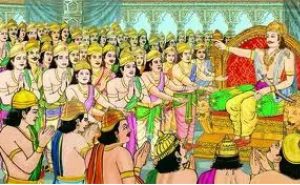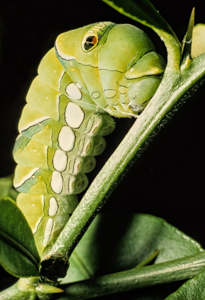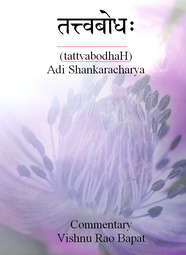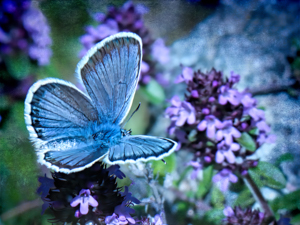Anuvaka 5 of Brahman Valli of Taittiriya Upanishad discusses two types of happiness: Anandamaya kosa and Atmananda. Interior to and subtler than the intellect sheath is Anandamaya kosa (bliss sheath) which is considered as Atma. Intellect sheath is relegated to the status of non-Atma. Bliss-sheath is subtle and assumes the shape of food-sheath (gross body). Its head is priya (joy), lefthand side is moda (hilarity), righthand side is pramoda (enjoyment), bliss is the trunk, and Brahman is the tail, the foundation. The state of deep sleep is bliss sheath. There is an experience of happiness a waking person recollects from memory.
Tag Archives: bliss
mANDUkya upaniShad Part 6
Mantra 5
*** Read Part 5 ***
यत्र सुप्तो न कञ्चन कामं कामयते न कञ्चन स्वप्नं पश्य्ति तत् सुषुप्तम्।
सुषुप्तस्थान एकिभूतः प्रज्ञानघन एवानन्दमयो ह्यानन्दभुक् चेतोमुखः प्राज्ञस्तृतीयः पादः॥ ५॥
yatra supto na ka~nchana kAmaM kAmayate na ka~nchana svapnaM pashyati tat suShuptam |
suShuptasthAna ekibhUtaH praj~nAnaghana evAnandamayo hyAnandabhuk chetomukhaH prAj~nastRRitIyaH pAdaH || 5 ||
tat suShuptam – That (is called) the deep-sleep state
yatra supto – in which the sleeper
kAmyate na ka~nchana kAmaM – desires nothing (not any desired objects)
na pashyati ka~nchana svapnaM – nor sees any dreams.
tRRiitIyaH pAdaH – The third aspect
prAj~naH – (is called) ‘the one who knows or understands’,
suShuptasthAna – the state of deep sleep.
ekibhUtaH – (In this state), everything is undifferentiated (literally ‘one element’),
praj~nAnaghana eva – just a homogenous mass of Consciousness
AnandamayaH – full of bliss,
hi Ananda bhuk – indeed the ‘enjoyer’ of bliss.
chetomukhaH – (Literally) it is the one whose mouth is intelligence.
The third aspect of the Self is prAj~na. This is the deep-sleep state in which one neither desires anything nor sees any dream. Everything is undifferentiated; simply blissful Consciousness alone, gateway to the other two cognitive states.
Continue readingQ.519 How can one experience the bliss?
Q: In ‘The Book of One’, you say: “If our true nature were allowed the freedom to experience to the full, what then? The Brihadaranyaka Upanishad tells us that “All the joys of the entire cosmos put together would be only a small drop of the bliss of this Supreme Being. Whatever little satisfaction we have, whatever pleasures we have, whatever joys we are experiencing, whatever be the happiness of life – all this is but a reflection, a fractional distorted form, a drop, as it were, from this ocean of the Absolute.” (Ref. 7)
Is there a way to get a taste such an ocean of joy while not ‘realized’?
A: This is a good question and highlights the dangers of attempting to relate the more ‘rapturous’ statements of the scriptures to the mundane experiences of life! When the Upanishad talks about the ‘bliss of this Supreme Being’, it cannot mean this literally. Brahman is non-dual, part-less, changeless, does not ‘experience’ or ‘know’ etc. In fact, whenever the word ‘bliss’ (Ananda) is encountered, it is a good idea to substitute ‘eternal’ (ananta) so as not to risk such a thought process. (See discussions at the AV site on ‘satyaM j~nAnamanantaM brahma’.)
Continue readingQ.501 Experiencing AtmA
Q: I would like to tell you about an experience I had recently.
I was walking the park and suddenly everything became clearer before my eyes and I was astonished I was like “ah….” in those few moments everything was myself and I was everything. I was the pavement I was walking, the trees, the bushes, the fences and the whole space was filled with myself without slightest gap like water fills a sea. I was everything and everywhere. I was omnipresent and all pervasive. I didn’t have a specific location as I normally experience with out body a specific location. At that very moment of experience I asked myself “what am I?” The answer very clearly and immediately dawned in me “peace, consciousness and bliss” it was an incredible experience of peace and awareness. It left a profound peace and awareness in me that since then all my desires have disappeared and I am in total peace all the time and nothing however good or bad from the outside moves me any longer.
Is this the experience or awareness of the Atma?
A: This is not really a question that is amenable to a short answer. There is a lot about it in my next book (‘Confusions in Advaita, Vol. 1’).
The short answer is ‘no’. You cannot ‘experience’ Atman. Experience requires an experiencer and a thing experienced – and that would be duality. You could also say that anything you experience cannot be Atman. You are Atman – the conscious experiencer – and anything experienced must be anAtman. But you might also say that, since reality is non-dual, there is only Atman-Brahman. Therefore, whatever you experience must also be Brahman.
Enlightenment is the intellectual realization of the truth of all this. It requires mental purification and then a process of listening to the teaching from a qualified teacher, clarifying any doubts through questioning and then a period of mentally going over all of this until it is clear and certain.
But your experience is not to be denigrated. It should serve as an incentive to investigate all of this properly!
‘brahman,’ the Bliss – 2/2
Everyone must face the consequences of his/her actions. But who is it that ensures it? Who brings a guy back, once he is dead, and make him reap his just desserts?
The scripture only can provide an answer. And the answer is:
विज्ञानमानन्दं ब्रह्म … | — 3.9.28 (7), brihadAranyaka
Meaning: Knowledge, Bliss, brahman.
Shankara explains that It is Pure Intelligence and is also Bliss. It is a Bliss not smitten with pain. It is serene, beneficent, matchless, spontaneous, ever content and homogeneous, he amplifies.
Shankara, however, says, we cannot close the issue at that. We should explore and understand better what exactly the word “Bliss” would mean.
In our normal parlance, “the word ‘bliss’ is generally known to denote pleasure.” The shruti uses the word ‘bliss’ as an adjective to brahman. Can we infer from this that shruti says brahman is pleasurable?
Here are a few more examples where the Upanishads talk of brahman and Bliss: Continue reading
‘brahman,’ the Bliss – 1/2
 Ha, finally, a gentle streak of relief seems to have descended on to the faces of the assembled august Audience, sitting on the edge of their seats for hours with knotted foreheads, wide-open eyes and mouths, waiting in tension for the next onslaught of verbal missiles. None in the Royal Assembly could answer the final question of the Challenger and that decided what was at stake for the day. The fierce war of words seems to have come to a close when the well-statured Pundit, an embodiment of Knowledge Supreme, just began to take slow and steady steps, along with a horde of his disciples, followers and admirers, towards the exit door of the Royal Court. The gathered experts started to wipe the drops of sweat on their bald pates, foreheads and chest using their upper garment as a hand towel. Rolls of murmurs and exchanges opened up among small groups of the men, cascading into unclear sounds. Some people were talking within themselves or speaking to nobody in particular as they recapitulated the dense moments and the profound depths of the discussions. Continue reading
Ha, finally, a gentle streak of relief seems to have descended on to the faces of the assembled august Audience, sitting on the edge of their seats for hours with knotted foreheads, wide-open eyes and mouths, waiting in tension for the next onslaught of verbal missiles. None in the Royal Assembly could answer the final question of the Challenger and that decided what was at stake for the day. The fierce war of words seems to have come to a close when the well-statured Pundit, an embodiment of Knowledge Supreme, just began to take slow and steady steps, along with a horde of his disciples, followers and admirers, towards the exit door of the Royal Court. The gathered experts started to wipe the drops of sweat on their bald pates, foreheads and chest using their upper garment as a hand towel. Rolls of murmurs and exchanges opened up among small groups of the men, cascading into unclear sounds. Some people were talking within themselves or speaking to nobody in particular as they recapitulated the dense moments and the profound depths of the discussions. Continue reading
Q. 473 TM
Q: Good afternoon, I wonder if i may ask you about meditation please ? In particular TM, Transcendental Meditation.
I have been meditating twice daily for two years now and have not noticed any changes, no more calmness or anything really. I enjoy it while i do it but the feeling does not carry over into daily life.
From your experience would it be best to give it up or persevere a little longer please ? Is there something better than thus type of meditation?
A: Can you describe in some detail what you actually do and what you find? Continue reading
The Chrysalis (Part 3)
The sheath-related verses in the Panchadashi occur in Chapter 1:
- The five sheaths of the Self are those of the food, the vital air, the mind, the intellect and bliss. Enveloped in them, it forgets its real nature and becomes subject to transmigration.
- The gross body which is the product of the quintuplicated elements is known as the food sheath. That portion of the subtle body which is composed of the five vital airs and the five organs of action, and which is the effect of the rajas aspect of Prakriti is called the vital sheath.
- The doubting mind and the five sensory organs, which are the effect of Sattva, make up the mind sheath. The determining intellect and the sensory organs make up the intellect sheath.
- The impure Sattva which is in the causal body, along with joy and other Vrittis (mental modifications), is called the bliss sheath. Due to identification with the different sheaths, the Self assumes their respective natures.
- By differentiating the Self from the five sheaths through the method of distinguishing between the variable and the invariable, one can draw out one’s own Self from the five sheaths and attain the supreme Brahman.
(These are from the translation by Swami Swahananda.) Continue reading
The Chrysalis (Part 1)

This is the first of a 3-part blog that I originally posted to Advaita Academy, on the subject of the pa~ncha kosha prakriyA, probably better known to most as the metaphor of the ‘Five Sheaths’.
Simplistically, this is the idea that there are various levels of identification of ‘Who I really am’ with aspects of the body-mind and that these have to be recognized and dropped so that I can realize my true nature.
However, because of the way that this idea is sometimes presented, there is often a serious misunderstanding on the part of the seeker who, taking the metaphor in a more literal sense, mistakenly believes that the self is literally ‘covered over’ by these ‘layers’ and somehow has to be ‘uncovered’, like some Russian doll. This misunderstanding may be reinforced by the notion of the Self being ‘hidden in the cave of the heart’ – another potentially misleading idea that I have discussed before. Continue reading
Tattvabodha – Part 29

Part 29 of the commentary by Dr. VIshnu Bapat on Shankara’s Tattvabodha.This is a key work which introduces all of the key concepts of Advaita in a systematic manner.
The commentary is based upon those by several other authors, together with the audio lectures of Swami Paramarthananda. It includes word-by-word breakdown of the Sanskrit shloka-s so should be of interest to everyone, from complete beginners to advanced students.
Part 29 explains what happens to the j~nAnI and his accumualted karma on enlightenment.
There is a hyperlinked Contents List, which is updated as each new part is published.

